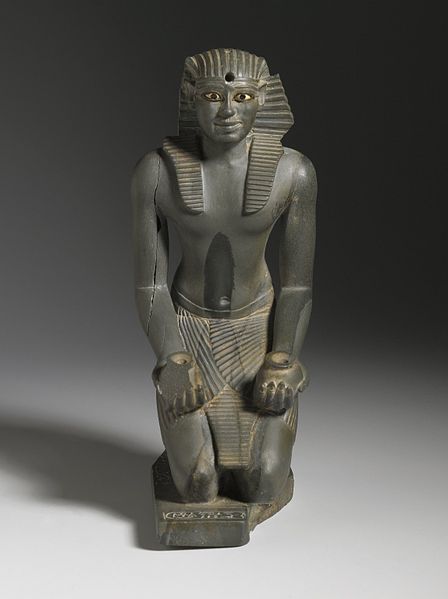Thutmose III, sometimes called Thutmose the Great, was the sixth pharaoh of the 18th Dynasty. Officially he ruled Egypt from 28 April 1479 BC until 11 March 1425 BC, commencing with his coronation at the age of two and concluding with his death, aged fifty-six; however, during the first 22 years of his reign, he was coregent with his stepmother and aunt, Hatshepsut, who was named the pharaoh. While he was shown first on surviving monuments, both were assigned the usual royal names and insignia and neither is given any obvious seniority over the other. Thutmose served as the head of Hatshepsut's armies. During the final two years of his reign, he appointed his son and successor, Amenhotep II, as his junior co-regent. His firstborn son and heir to the throne, Amenemhat, predeceased Thutmose III.
Thutmosis III statue in Luxor Museum
A fragment of a wall block inscribed with the birth-name of Thutmose III. Now in the Petrie Museum of Egyptian Archaeology, London
Upper part of a statue of Thutmose III
Thutmose III smiting his enemies. Relief on the seventh pylon in Karnak
Pharaoh is the vernacular term often used for the monarchs of ancient Egypt, who ruled from the First Dynasty until the annexation of Egypt by the Roman Republic in 30 BCE. However, regardless of gender, "king" was the term used most frequently by the ancient Egyptians for their monarchs through the middle of the Eighteenth Dynasty during the New Kingdom. The earliest confirmed instances of "pharaoh" used contemporaneously for a ruler were a letter to Akhenaten or an inscription possibly referring to Thutmose III.
The Mask of Tutankhamun from tomb KV62 in the Valley of the Kings. Pharaohs' tombs were provided with vast quantities of wealth
A guardian statue wearing the red crown which reflected the facial features of the reigning king, probably Amenemhat II or Senwosret II, and which functioned as a divine guardian for the imiut. Made of cedar wood and plaster c. 1919–1885 BCE
Uraeus depicted on king Den, ivory label found at his tomb in Abydos, c. 3000 BCE, British Museum, London
Statuette of Pepy I (c. 2338-2298 BCE) wearing a nemes headdress Brooklyn Museum, New York








